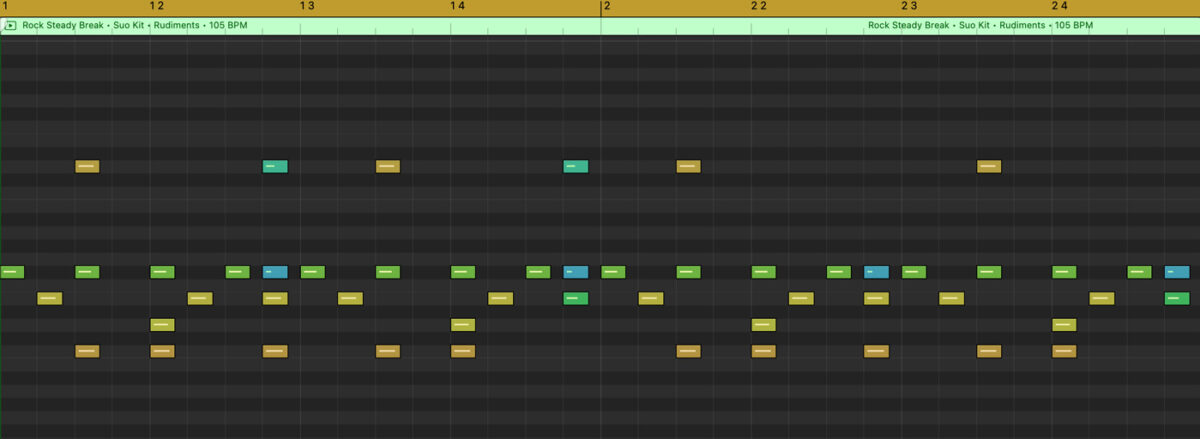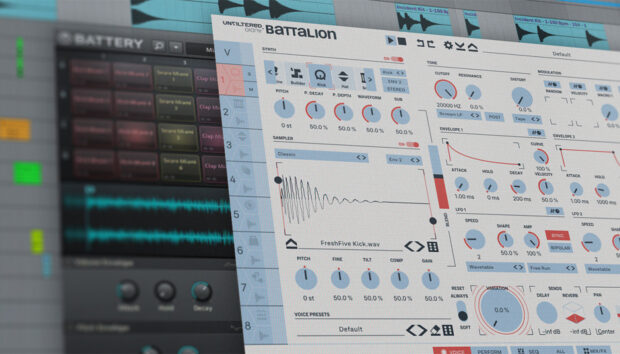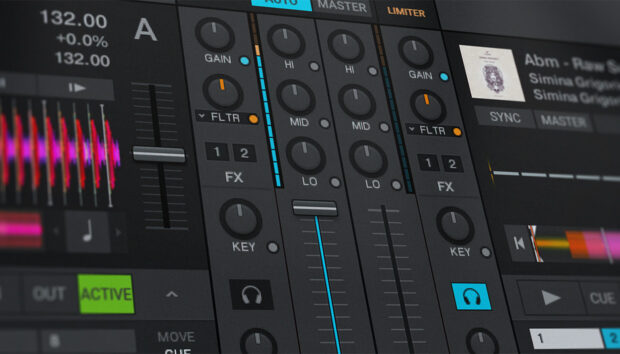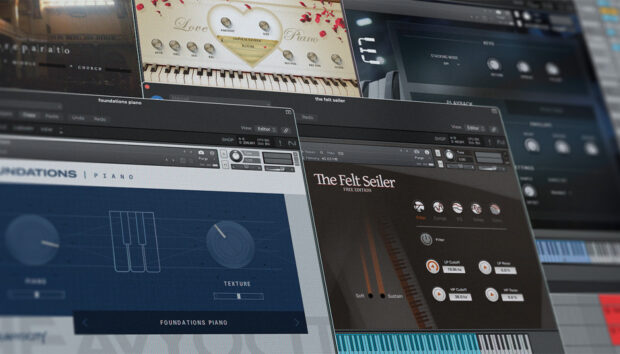
Famous drum breaks (or breakbeats) are more than just beats – they’re actually the foundation of genres like hip hop and drum and bass. Drum breaks provide plenty of soul to get bodies moving and groovin’. So, whether you’re just learning how to produce music or you’ve been at it for ages, they’re worth learning about!
In this piece we’ll explore what drum breaks are, dive into some of the most iconic breakbeats throughout history, and show you how to create your own. Ready to break it down?
Jump to these sections
Follow along with the Rudiments Kontakt instrument that includes crisp, punchy, and versatile drums for your productions.
What are drum breaks?
Drum breaks originated as drum solos within funk and soul tracks – a moment for drummers to shine with their rhythmic prowess and show off new and unique drum patterns. Later, these solos caught the ear of hip-hop producers who began sampling these breakbeat loops while programming drums, laying a foundation for MCs to rap over. This practice not only created new music, but also helped craft the sound and rhythmic vibe of the entire drum and bass genre, weaving its way into various other styles of electronic music along the way.
Drum breaks transitioned from mere solos to become a fundamental element of modern music, demonstrating their versatility and enduring appeal across the musical spectrum.
10 best drum breaks of all time
Now that you know what drum breaks are and where they came from, let’s take a look at how to recreate ten of the most famous drum breaks. For these demonstrations, we will be using several of the drum kits found in the Rudiments Kontakt instrument.
Rudiments is perfect for crafting breakbeats because it’s full of modern sounding hip hop drum kits and patterns, but it still has plenty of that retro grit we’ve all come to love.
Also, I’ve included links to MIDI files for each drum break so you can easily download them for free and use them with the Rudiments drum kits in your own productions. I hope they help to spark new inspiration in your beat making sessions!
1. “Amen” break
The “Amen” break, a six-second drum solo from The Winstons’ 1969 track “Amen, Brother,” is perhaps the most famous drum break in music history, forming the basis of countless jungle and breakbeat tracks.
To recreate the “Amen” break, focus on mimicking the original’s tight snare, crisp hi-hats, and booming kick drum. Pay close attention to the break’s swing and shuffle to capture its groove.

Here’s what the “Amen” break sounds like played with the “Shombo Kit” in Rudiments at 130 BPM.
2. “Funky Drummer” break
Played by Clyde Stubblefield, the break from “Funky Drummer” by James Brown has been widely sampled in hip hop music, known for its snappy snare and syncopated rhythm.
To recreate the “Funky Drummer” break, program a groove with a strong emphasis on the snare backbeat. Utilize subtle swing settings and dynamic velocity changes on the snare and hi-hats to achieve this break’s feel.

Here’s what the “Funky Drummer” break sounds like played with the “RickOShea Kit” in Rudiments at 101 BPM.
3. “I Got You” break
“I Got You (I Feel Good)” is another one of James Brown’s most recognizable and celebrated tracks. The song’s infectious rhythm and Brown’s dynamic delivery have made it a staple of funk music and a favorite for samples in various genres.
To recreate this simple, but iconic beat, emphasize the downbeat with the kick and add syncopation with tight and snappy snares on the 2 and the 4. Experiment with slight open hi-hat accents on the off-beats to add more texture and dynamics to the groove.

Here’s what the “I Got You” break sounds like played with the “ReignMan Kit” in Rudiments at 145 BPM.
4. “Impeach the President” break
Found in “Impeach the President” by The Honey Drippers, this drum break’s laidback groove and politically charged message have made it a favorite among hip hop producers.
To recreate this catchy breakbeat, start with the kick drum, laying down a solid groove that anchors the beat. The snare is critical, providing the backbeat on the 2 and 4 counts. The hi-hat plays a steady eighth-note pattern throughout the break, but experiment with slightly opening the hi-hat at certain points to add texture and a live feel to the beat. Sampling and looping a vinyl crackle overlay can also add to the authenticity.

Here’s what the “Impeach the President” break sounds like played with the “Testra Kit” in Rudiments at 96 BPM.
5. “Funky President” break
“Funky President (People It’s Bad)” is yet another iconic track by James Brown. The drum break in this song is played by Allan Schwartzberg and is particularly famous for its tight, funky groove. It’s been sampled by numerous artists across various genres, but has been one of the most foundational beats in the development of hip hop.
To recreate this famous drum break, start with the grooving kick and then use the snare to provide the fundamental backbeat (but, also feel free to include some ghost notes and subtle variations to add to the groove’s complexity). The hats in this breakbeat are played with a sense of urgency and motion, often incorporating open hi-hat accents to enhance the groove.

Here’s what the “Funky President” break sounds like played with the “Laren Kit” in Rudiments at 105 BPM.
6. “Ashley’s Roachclip” break
In “Ashley’s Roachclip” by The Soul Searchers, the mid-track drum break has a laid-back groove that has been widely sampled in hip hop, pop, and electronic music.
To recreate this common breakbeat, start with a steady backbeat on the snare drum to anchor the groove. Then, layer this with a syncopated hi-hat rhythm that provides that distinctive shuffle and feel. Finally, incorporate a kick drum pattern that complements the snare, playing around with the backbeat to enhance the groove’s overall swing and momentum.

Here’s what the “Ashley’s Roachclip” break sounds like played with the “HenFrew Kit” in Rudiments at 95 BPM.
7. “Rock Steady” break
“Rock Steady” by Aretha Franklin is celebrated for its infectious groove and innovative breakbeat, marking it as a pivotal track in soul and funk music. The breakbeat’s compelling rhythm, characterized by its solid kick drum, snappy snare, and intricate hi-hat patterns, laid the groundwork for future genres where sampling became a key element.
To recreate this rhythm, start with a foundational kick-snare pattern that emphasizes the beat’s steadiness, layer in hi-hat cymbals for rhythmic texture, and incorporate congas or bongos to capture the song’s distinctive syncopation and energy.

Here’s what the “Rock Steady” break sounds like played with the “Suo Kit” in Rudiments at 105 BPM.
8. “Cold Sweat” break
“Cold Sweat” by James Brown is iconic for its raw energy and groundbreaking breakbeat, credited with laying the groundwork for funk and influencing countless genres thereafter. The drum pattern, crafted by Clyde Stubblefield, is marked by a syncopated rhythm focusing on the interplay between the kick and snare, underpinned by a steady hi-hat.
To recreate it, emphasize the snare’s off-beat accents, maintain a steady kick drum pattern for the groove’s backbone, and use hi-hat cymbals to keep the rhythm driving forward, capturing the song’s dynamic and revolutionary spirit.

Here’s what the “Cold Sweat” break sounds like played with the “Kovax Kit” in Rudiments at 120 BPM.
9. “Come Dancing” break
“Come Dancing” by Jeff Beck is characterized by its high energy and somewhat danceable rhythm. This track, renowned for its fusion of jazz, rock, and funk elements, has an interesting breakbeat that combines both rock and jazz drumming techniques that emphasize feel and dynamics.
To recreate this famous drum break, begin with a solid kick drum pattern and add a snappy snare on the backbeats to drive the rhythm forward. Layer in a complex hi-hat or ride cymbal pattern that plays with syncopation and swing to give the track its characteristic bounce and energy.

Here’s what the “Come Dancing” break sounds like played with the “Kai Kit” in Rudiments at 97 BPM.
10. “Express Yourself” break
“Express Yourself” by Charles Wright & The Watts 103rd Street Rhythm Band is known for its vibrant energy and danceability, making it a classic funk anthem.
To create the breakbeat in this track, focus on laying down a solid groove with a tight kick and snare pattern that emphasizes the backbeat. Add a syncopated bass line to drive the rhythm, and incorporate open hi-hat hits for a distinctive funk feel. The essence of this breakbeat lies in its simplicity and pocket, making it crucial to lock in the groove with precision and feel.

Here’s what the “Express Yourself” break sounds like played with the “Marshins Kit” in Rudiments at 92 BPM.
Start creating drum breaks in your music
As you’ve seen, drum breaks are more than just moments in music – they’re the building blocks of whole genres and the heartbeat of innovation in sound. Understanding and creating drum breaks can elevate your music to new heights. To dive deeper into crafting your own unique rhythms, check out the Rudiments Kontakt instrument. It’s sure to inspire and enhance your musical productions. Happy breakbeat making!















